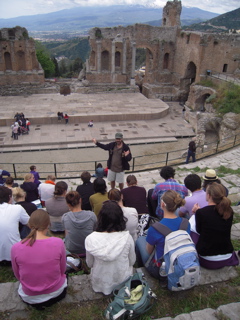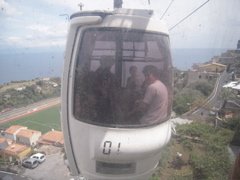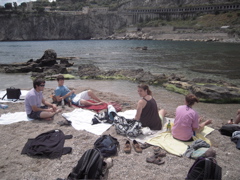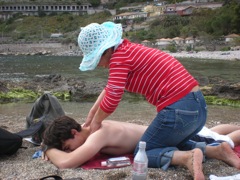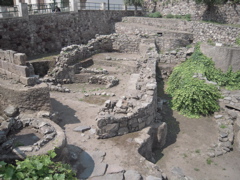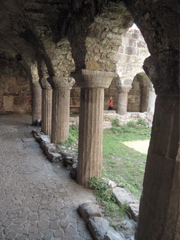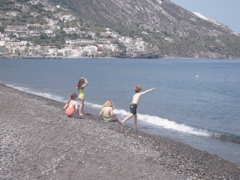This week we spent Thursday at the opera in Catania, and Friday and Saturday at two of the more up-market resorts in the area, first, Taormina, with its wonderful Hellenistic/Roman theater, and then on Saturday, as part of an excursion, the island of Lipari, supposed home of Aeolus and his bag of winds.
The opera was Verdi’s slightly scandalous Ernani, in the famous Teatro Massimo Bellini just down the street from the study center. It is not, by modern standards a large auditorium, so the acoustics and viewing are excellent; the sets were fabulous, and the denouement suitably tragic. Photography is strictly controlled, but the building itself is worth a visit; there are photos and histories here.
Friday being May the first, Labor day in Italy, Taormina was packed, and there were plenty of other visitors to the theater, but we also got to take the funivia down from the peak on which the theater is place to the shore and spend the afternoon at the Isola Bella, a beautiful beach and island nature reserve (though the water was filled with purple meduse, making swimming off-limits). The cable car was not everyone’s favorite moment, but the lido was lovely:
Massage not included…
For more pictures of Taormina, see here.
Saturday morning we got up at the crack of dawn, drove by bus to Milazzo and then took the hydrofoil 22 km north to the beautiful volcanic island of Lipari. The weather was great, but Lipari is also of academic interest because it was a major point of connection between Sicily and the mainland in the Bronze Age, and then hosted a thriving joint native-Greek colony when around 575 Pentathlus, a Cnidian and supposed descendant of Heracles, failed to establish a colony at Lilybaeum/Marsala, but then while sailing through the Tyrrhenian sea was received by the Liparians. On the citadel can be seen large megaron-size huts from the Bronze Age, as well as housing and roads from the classical and Hellenistic periods. In the museum is a fabulous collection of Ausonian, Italic and Greek pottery, especially red-figure Attic, but also a wonderful collection of small comic and tragic masks used in burials in the Hellenistic period and Liparian coins with tridents on them. A number of Doric capitals and Roman columns also found their way into a small and slightly rickety Norman cloister dating from 1131.
In the afternoon, we decamped to the beach at Cannetto… Next week Piazza Armerina and Medea in the Greek theater at Syracuse!

